Art Fairs
‘I Have an Enormous Belief in London’: Frieze Dealers Make Their Case in the Fair’s Early Hours as Brexit Looms and Galleries Flirt With Paris
Major sales were reported, but also major questions about how to set a course in the future.
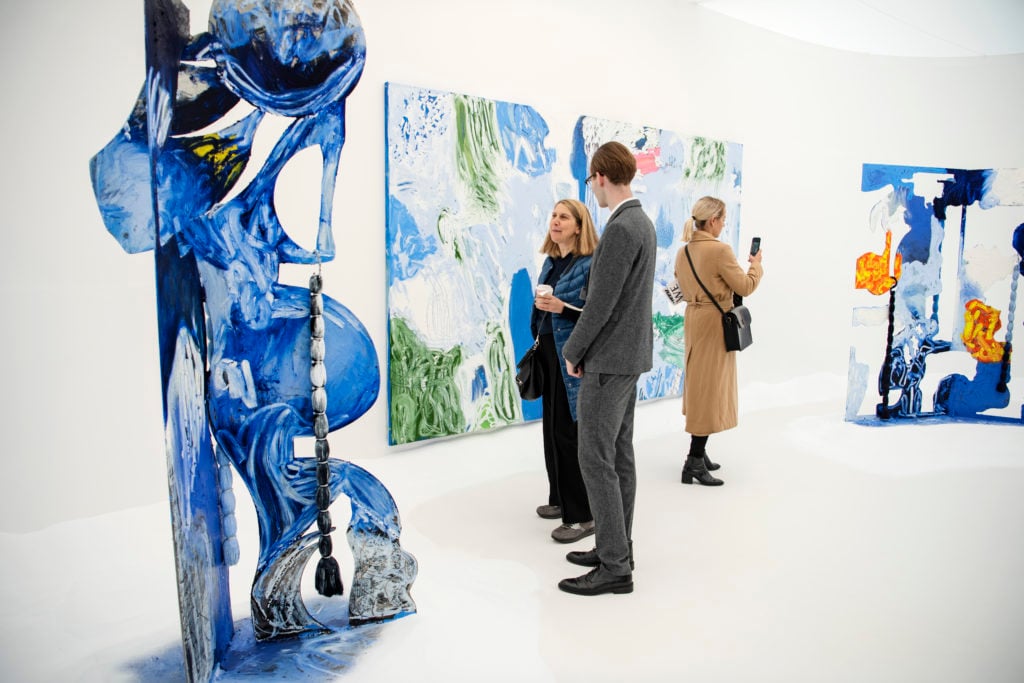
Major sales were reported, but also major questions about how to set a course in the future.

Nate Freeman

For the past three years each edition of Frieze London has had the specter of Brexit haunting the aisles, forcing the dealers and collectors at England’s most important fair to consider whether the art market will survive leaving the European Union. But in the last two editions, the status of Brexit was still a bit abstract. No more: When collectors arrived for the first Frieze London VIP preview day Wednesday morning, the Halloween deadline was looming weeks away and prime minister Boris Johnson had adopted as an official slogan “Get Brexit Done.”
In the months leading up to Frieze, several galleries started making moves that showed just how seriously they were taking the threat of Brexit. David Zwirner announced that he would be opening a gallery in Paris, stating clearly that “Brexit changes the game.”
“After October, my London gallery will be a British gallery, not a European one,” he said. “I am European, and I would like a European gallery, too.”
And when Frieze attendees jostled to the front of the line to the tent at Regent’s Park Wednesday, news got out that White Cube, which is so tied to the rise of the YBAs it’s practically synonymous with the the phrase “London gallery,” would be opening an office and viewing space in Paris. In the booth, director Mathieu Paris (real name) said that the space would be on the Avenue Matignon, putting it close to the French outposts of powerhouses such as Gagosian and Christie’s.
What’s more, later that same day, a report said that Pace was looking to open a space in Paris as well, though it’s unclear if they have a location. Pace CEO Marc Glimcher declined to comment.
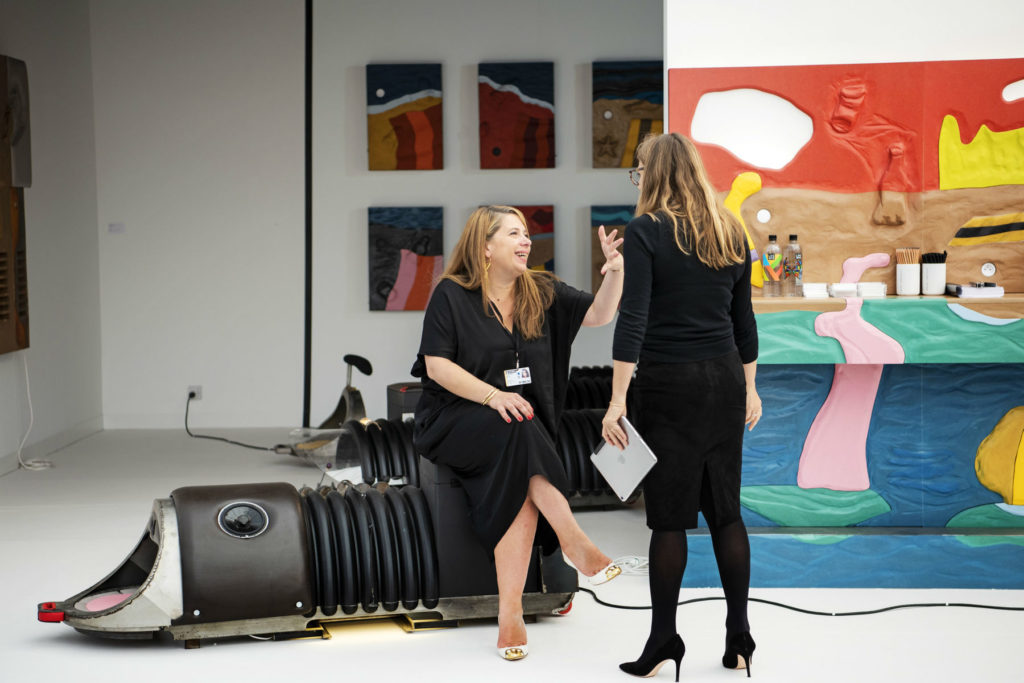
kamel mennour, Frieze London 2019
Photo by Linda Nylind. Courtesy Linda Nylind / Frieze.
And yet, even as Uber riders are subjected to radio ads advising Brits on how to prepare for the pull-out, things did not seem so apocalyptic inside the tent—in fact, dealers reported that sales were steady, with several larger galleries pre-selling enough work to sell out early. When word reached me that Gagosian had sold its entire booth of eye-catching neon yellow paintings by Sterling Ruby, for $325,000 each, the fair had been open for ten minutes.
And not all galleries are looking for alternatives to Britain. Like White Cube, Sadie Coles is one of the city’s most important galleries, so I asked Coles if she, like White Cube, was thinking of hedging the Brexit ordeal by opening a continental outpost in, say, Paris. The answer was an emphatic no.
“I’m looking to open another gallery in London,” Coles said. “I have an enormous belief in London. I’m a Londoner. My parents are Londoners. It’s a survivor of a city. Whatever happens, we’ll get through it.”
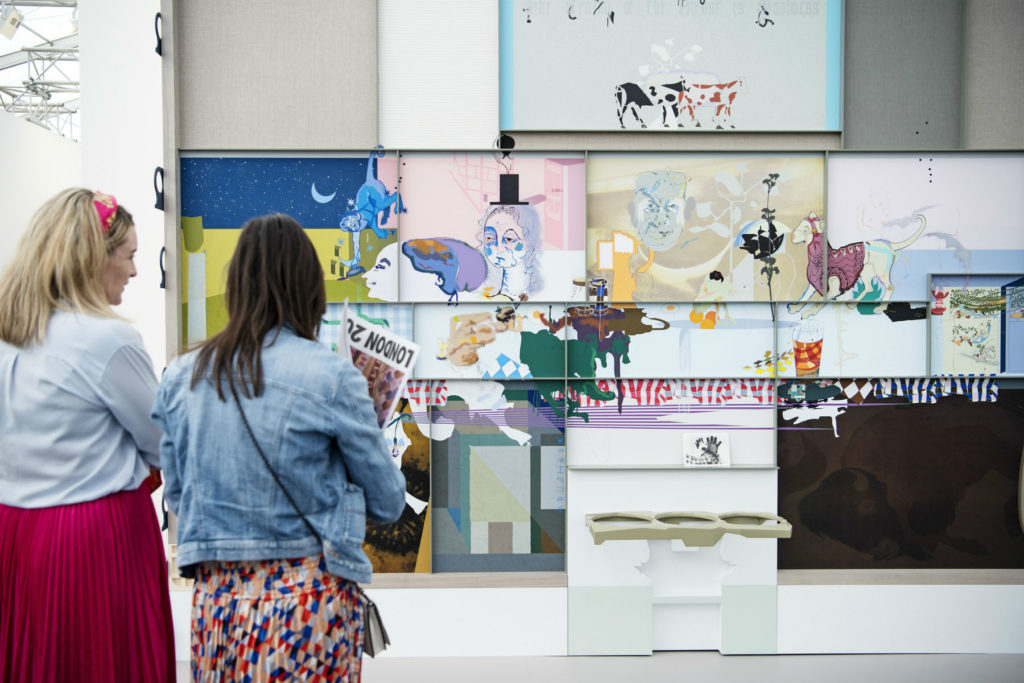
Sadie Coles, Frieze London 2019
Photo by Linda Nylind. Courtesy Linda Nylind / Frieze.
She added that her gallery’s large wall sculpture by Alex Da Corte, True Love Will Always Fine You in the End (2019), had sold in the fair’s first hour for $85,000. De Corte, who had starring roles in the Carnegie International and the Venice Biennale, is represented by Karma in New York, where a space-altering show has been generating hosannas since opening late last month. Coles told me that she, too, now represents him in London, and that she’ll stage a solo show of his works at FIAC later this month.
Coles has the advantage of tethering her booth to what’s on at the gallery. For instance, there’s a big Alvaro Barrington here at Frieze, which will be familiar to those who visited her Davies Street gallery in Mayfair, where there’s a show of big Alvaro Barrington paintings. Similarly, Kamel Mennour staged a inventive and playful solo booth of new work by Neil Baloufa at Frieze to correspond with the Neil Baloufa show at the gallery on Brook Street, right next to Claridge’s.
Mennour’s booth was anchored by Beloufa’s Beach (2019), which doubled as a desk for directors to rest iPads on or charge phones. The artist’s works often incorporate power jacks to plug in chargers. It sold for €80,000, but several of the smaller works were selling for the relatively reasonable price of €20,000 (for the main sector of the fair). A gallery director explained that the gallery was keeping the prices low to try and get younger collectors to buy.
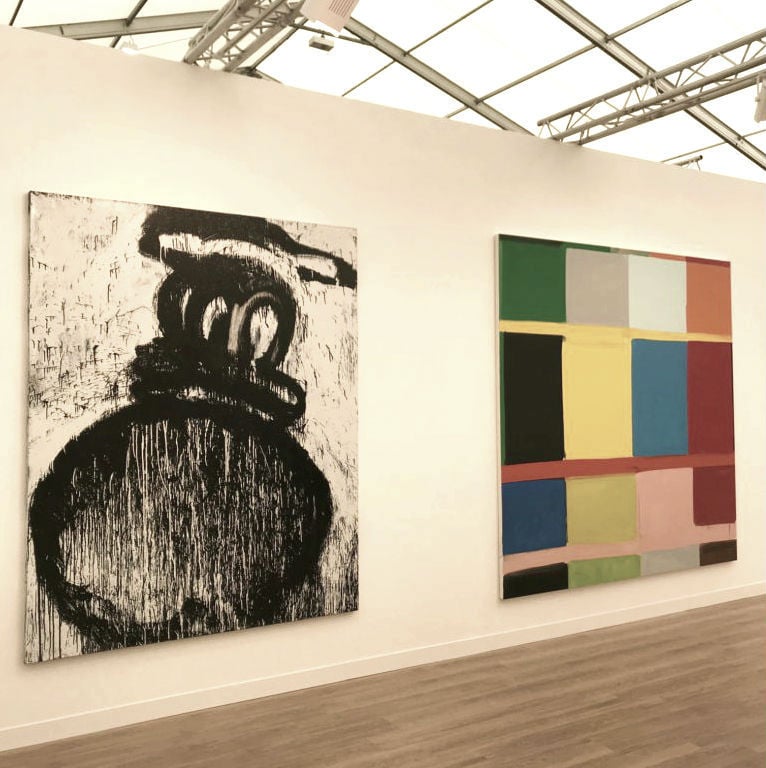
Joyce Pensato and Stanley Whitney at the Lisson booth.
Other galleries were firmly catering to the mega-collector set, including Dakis Joannou and Maja Hoffmann, both of whom were seeing darting around the fair. (Joannou, who has a marble gallery attached to his house in Athens, said he comes to Frieze because he likes the layout.)
There to provide on the higher end was Zwirner gallery, which sold a Kerry James Marshall for $3.4 million to an American museum, and Hauser & Wirth, which reported $14 million in business within the first hours of the fair, Brexit be damned. Philip Guston’s Arm (1974) sold for a price in the range of $5 million, and a Mark Bradford sold for $3.4 million—high, but not as high as the prices for work in his solo show at Hauser & Wirth’s Mayfair gallery. That show sold out, with one painting selling for more than $10 million.
Gallery director Neil Wenman said that, whatever happens with Brexit, at the moment things looks fairly positive, at least in terms of how many people showed up at the opening bell.
“The hotels are full in London,” he said. “It’s an international market—it’s not a London market, it’s not a UK market. The art world is an international market, and for that reason the market’s still very strong.”
Lisson sold all four of the large-scale works by Stanley Whitney that it had in its booth, three priced at $350,000 and one larger one priced at $450,000. Three went to institutions: one in Norway, one in the Middle East, and one in Lebanon. Start guessing which ones. The booth paired his worked with similarly monumental paintings by Joyce Pensato, who died earlier this year. As she neared the end, Whitney, a good friend, came to visit her, and she insisted that they still stage a show together.
“Before she got really ill, we planned to show together, and now here it is,” Whitney explained, standing in the booth. (Out of respect, the Pensato works are not for sale.)
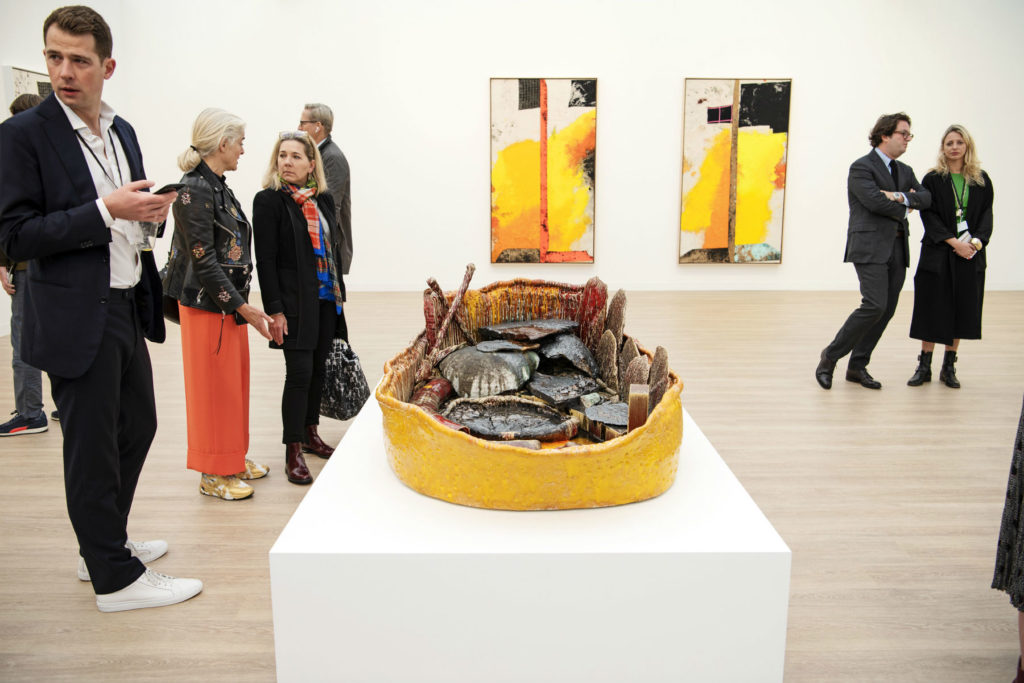
Visitors at the booth of Gagosian at Frieze 2019 (paintings by Sterling Ruby at the back). Photo by Linda Nylind. Courtesy Linda Nylind / Frieze.
Elsewhere, PPOW sold a new work by Robin F. Williams for $50,000—there’s a long waiting list for the artist and the work went to a prominent collector, as the gallery tries to place the hotly desired artist in prestigious places. (A masterful Martin Wong painting depicting Bruce Lee was still available at the booth for $375,000, despite the fact that one of his works caused a bidding sensation last week at Sotheby’s.)
Galerie Thaddeaus Ropac’s Asia director Nick Buckley Wood told me that a grand golden Georg Baselitz, Nicht, nicht verloren (2019) sold for €1.2 million ($1.3 million) to a collector from Asia. That fact is somewhat surprising, as there did not seem to be much of a presence of Asian collectors at the fair. An Elizabeth Peyton painting, The Kiss, also went to an Asian collector, and sold for $575,000.
And David Kordansky Gallery brought a solo presentation of work by the California-based Ivan Morley, and sold out a few hours into the fair, with prices going for between $40,000 and $85,000.
Overall, the fair managed to feel livelier that in recent years. Fair director Victoria Siddall pointed to the fact that, in the face of Brexit, the fair has been pushing to become more representative of different parts of the world.
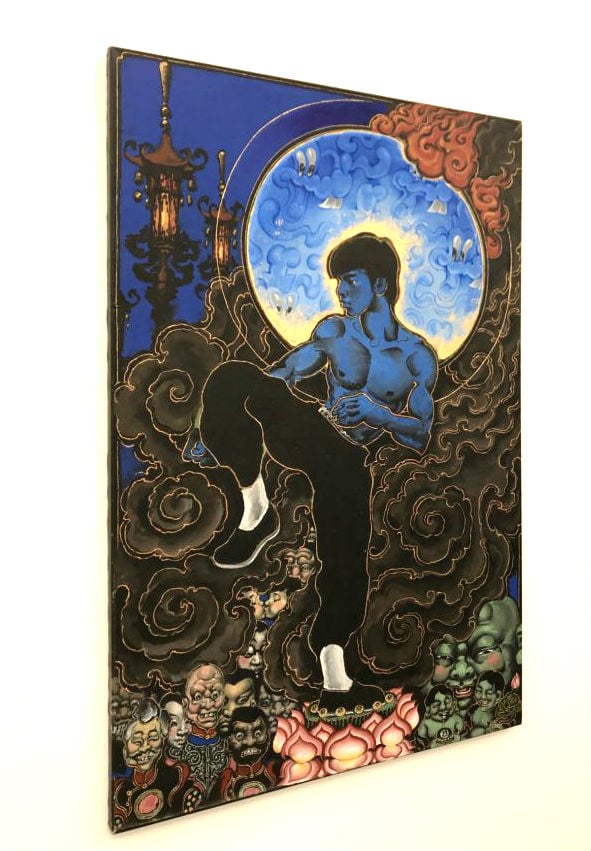
A Martin Wong painting of Bruce Lee, at P.P.O.W. Image: Nate Freeman.
“This is the most international fair we’ve ever had, with 35 countries represented,” she said, standing at the entrance of the fair. “And it feels very important at this political moment. It’s about bringing the world to London.”
And yet, rumors abounded that Zwirner, White Cube, and Pace won’t be the only major galleries announcing new spaces in Paris, especially seeing as that city’s main fair, FIAC, opens in exactly two weeks. Indeed, speculation abounds that Hauser & Wirth will be the next to plant a flag in the City of Light.
When I mentioned that rumor to Wenman, the gallery’s director, he started thinking aloud: Currently, apart from its spaces in London and in the English country town of Somerset, the gallery’s other European galleries are in Switzerland, the famously isolationist country which is certainly not in the EU. That leaves the mega-franchise’s only EU gallery to be the yet-to-open space in Menorca, Spain. Which is a pretty spot, and offers some great seafood, but not exactly an art market hub.
“If we, England, do eventually leave [the EU], then that will be our European gallery” he said.
Pressed on the meaning of that realization, Wenman did not rule out a new space in Paris.
“I mean, of course, Paris is major—the fact that everyone’s talking about it now, maybe, is spurred on by Brexit. But it’s already a major commercial art center,” he added. “I’m sure we’ll all be taking our French classes soon.”